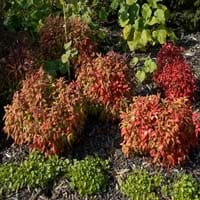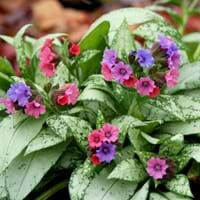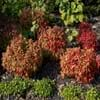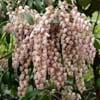Life Span
Perennial
Perennial
Type
Broadleaf Evergreen
Perennial
Origin
China, Japan
Hybrid origin
Types
Heavenly Bamboo, Nandina 'Colerno'
Dwarf Nandina 'Compacta'
Dwarf Nandina 'Filamentosa'
Heavenly Bamboo, Nandina 'Harbor Belle'
Heavenly Bamboo, Nandina 'Moon Bay'
Benediction lungwort, Excalibur lungwort
Habitat
low mountains, Mountain tops, Mountains, Valley
Forest edges, Mountains
USDA Hardiness Zone
6-11
4-8
AHS Heat Zone
Not Available
8-4
Sunset Zone
21,22
1a, 1b, 2a, 2b, 3a, 3b, 4, 5, 6, 7, 8, 9, 14, 15, 16, 17
Habit
Clump-Forming
Cushion/Mound-forming
Flower Color
Not Available
Pink, Rose, Blue Violet
Flower Color Modifier
Bicolor
Not Available
Fruit Color
Not Available
Not Available
Leaf Color in Spring
Green, Purple, Copper
Green, Gray Green, Silver
Leaf Color in Summer
Green, Purple
Green, Gray Green, Silver
Leaf Color in Fall
Green, Purple
Green, Gray Green, Silver
Leaf Color in Winter
Red, Green, Purple
Light Green
Leaf Shape
Acuminate
Lung shaped
Plant Season
Spring, Summer, Fall, Winter
Spring, Summer, Fall
Sunlight
Full Sun, Partial Sun, Partial shade, Full Shade
Partial Sun, Partial shade, Full Shade
Type of Soil
Loam, Sand
Clay, Loam, Sand
The pH of Soil
Acidic, Neutral, Alkaline
Acidic, Neutral, Alkaline
Soil Drainage
Well drained
Well drained
Bloom Time
Not Available
Early Spring, Spring, Late Winter
Tolerances
Drought
Drought
Where to Plant?
Ground
Ground
How to Plant?
Seedlings
Divison, Seedlings
Plant Maintenance
Medium
Medium
Watering Requirements
Do not water frequently, Needs less watering
Water when soil is dry, when new, water every week
In Summer
Lots of watering
Drought Tolerant
In Spring
Moderate
Average Water
In Winter
Average Water
Adequately
Soil pH
Acidic, Neutral, Alkaline
Acidic, Neutral, Alkaline
Soil Type
Loam, Sand
Clay, Loam, Sand
Soil Drainage Capacity
Well drained
Well drained
Sun Exposure
Full Sun, Partial Sun, Partial shade, Full Shade
Partial Sun, Partial shade, Full Shade
Pruning
Remove damaged leaves, Remove dead branches, Remove dead leaves
Remove damaged leaves, Remove dead branches, Remove dead leaves
Fertilizers
All-Purpose Liquid Fertilizer
All-Purpose Liquid Fertilizer
Pests and Diseases
Red blotch
Powdery mildew, Slugs
Plant Tolerance
Drought
Drought
Flower Petal Number
Not Available
Single
Foliage Texture
Fine
Coarse
Foliage Sheen
Glossy
Matte
Attracts
Mealybugs, Whiteflies
Not Available
Allergy
Not Available
Not Available
Aesthetic Uses
Bonsai, Borders
Showy Purposes
Beauty Benefits
Not Available
Not Available
Environmental Uses
Air purification
Air purification, Provides ground cover
Medicinal Uses
Antirheumatic, Antitussive, Astringent
Astringent, Demulcent, Diaphoretic, Diuretic, Emollient, Exoectorant, Homeopathy, Opthalmic, Resolvent
Part of Plant Used
Fruits, Leaves
Leaves
Other Uses
Used for making informal hedge
Used for its medicinal properties
Used As Indoor Plant
No
No
Used As Outdoor Plant
Yes
Yes
Garden Design
Container, Edging, Foundation, Groundcover, Hedges, Mixed Border, Topiary, Bonsai, Espalier
Edging, Groundcover, Mixed Border, Rock Garden / Wall
Botanical Name
NANDINA domestica 'Nana Purpurea'
PULMONARIA 'Berries and Cream' PP10597
Common Name
heavenly bamboo
sacred bamboo
nandina
Berries and Cream Lungwort, Lungwort
In Hindi
Dwarf Nandina
Lungwort
In German
Dwarf Nandina
Lungenkraut
In French
Nandina Dwarf
pulmonaire
In Spanish
Nandina enana
Lungwort
In Greek
Dwarf Nandina
Lungwort
In Portuguese
Nandina do anão
pulmonária
In Polish
Dwarf Nandina
płucnik
In Latin
Dwarf Nandina
Lungwort
Phylum
Tracheophyta
Ascomycota
Class
Magnoliopsida
Ascomycetes
Order
Ranunculales
Peltigerales
Family
Berberidaceae
Boraginaceae
Clade
Angiosperms, Eudicots
Angiosperms, Asterids, Eudicots
Tribe
Not Available
Boragineae
Subfamily
Not Available
Boraginoideae
Number of Species
Not Available
Season and Care of Dwarf Nandina and Lungwort
Season and care of Dwarf Nandina and Lungwort is important to know. While considering everything about Dwarf Nandina and Lungwort Care, growing season is an essential factor. Dwarf Nandina season is Spring, Summer, Fall and Winter and Lungwort season is Spring, Summer, Fall and Winter. The type of soil for Dwarf Nandina is Loam, Sand and for Lungwort is Clay, Loam, Sand while the PH of soil for Dwarf Nandina is Acidic, Neutral, Alkaline and for Lungwort is Acidic, Neutral, Alkaline.
Dwarf Nandina and Lungwort Physical Information
Dwarf Nandina and Lungwort physical information is very important for comparison. Dwarf Nandina height is 30.00 cm and width 60.00 cm whereas Lungwort height is 25.50 cm and width 30.50 cm. The color specification of Dwarf Nandina and Lungwort are as follows:
Dwarf Nandina flower color: Not Available
Dwarf Nandina leaf color: Green, Purple and Copper
Lungwort flower color: Pink, Rose and Blue Violet
- Lungwort leaf color: Green, Gray Green and Silver
Care of Dwarf Nandina and Lungwort
Care of Dwarf Nandina and Lungwort include pruning, fertilizers, watering etc. Dwarf Nandina pruning is done Remove damaged leaves, Remove dead branches and Remove dead leaves and Lungwort pruning is done Remove damaged leaves, Remove dead branches and Remove dead leaves. In summer Dwarf Nandina needs Lots of watering and in winter, it needs Average Water. Whereas, in summer Lungwort needs Drought Tolerant and in winter, it needs Adequately.





